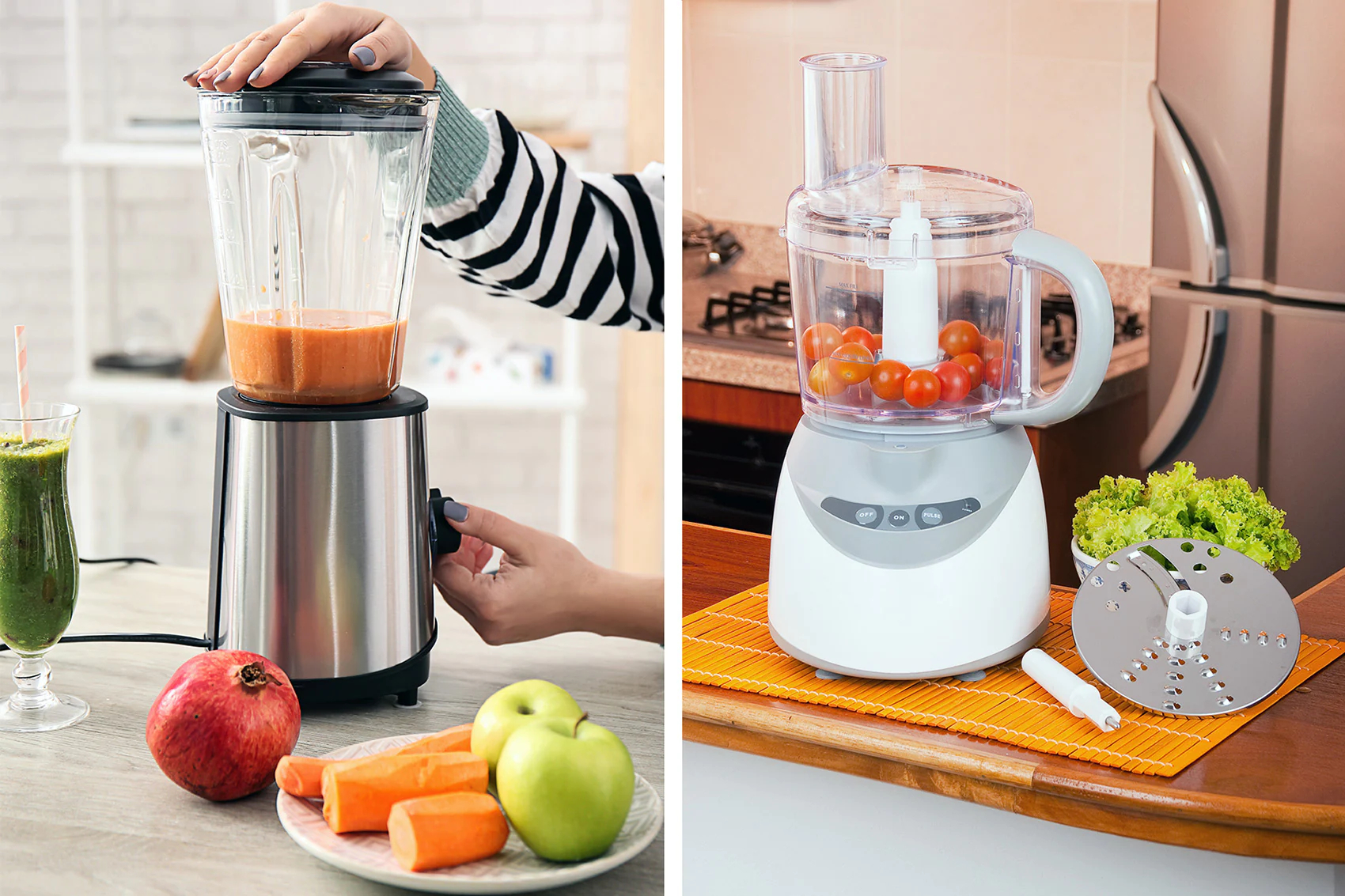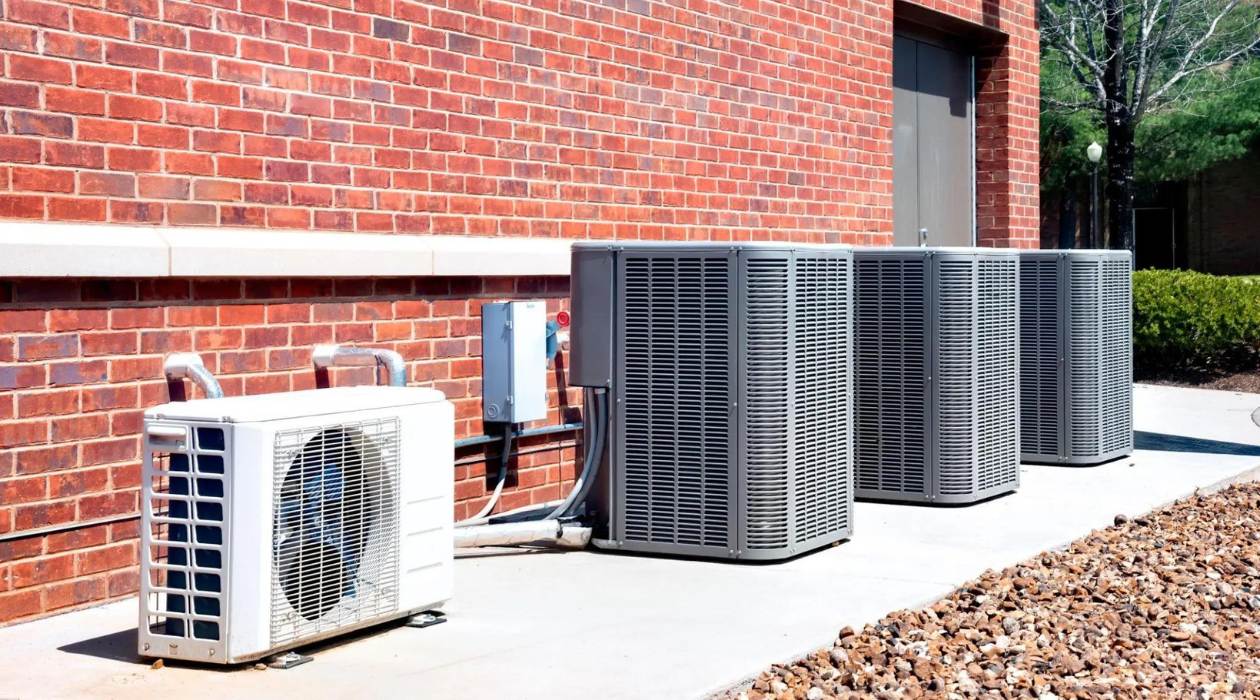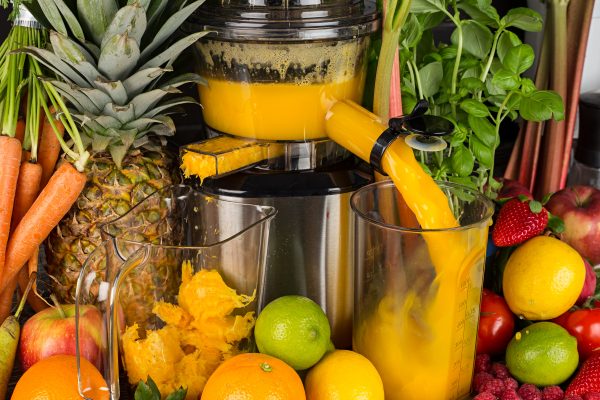Home>Articles>What Is The Difference Between A Blender And Food Processor


Articles
What Is The Difference Between A Blender And Food Processor
Modified: August 27, 2024
Discover the key distinctions between a blender and a food processor in this informative article. Find out which one best suits your cooking needs and enjoy culinary success.
(Many of the links in this article redirect to a specific reviewed product. Your purchase of these products through affiliate links helps to generate commission for Storables.com, at no extra cost. Learn more)
Introduction
Blenders and food processors are two essential kitchen appliances that can greatly simplify the cooking process. While they may appear similar at first glance, there are distinct differences between the two, and understanding these variances can help you determine which appliance is best suited for your culinary needs.
In this article, we will explore the disparities between blenders and food processors, examine their individual characteristics and functions, and provide insights on popular brands for each appliance. Whether you are a novice in the kitchen or a seasoned chef, having a clear understanding of these kitchen tools will enable you to make informed choices when it comes to your cooking endeavors.
So, let’s dive in and discover the world of blenders and food processors, and ultimately decide which one will be the perfect companion for your culinary adventures!
Key Takeaways:
- Blenders excel in creating smooth textures and are ideal for blending fruits, making smoothies, and pureeing ingredients, while food processors are versatile in chopping, slicing, and shredding tasks, offering precision and efficiency in food preparation.
- Understanding the differences between blenders and food processors is crucial in choosing the right appliance for specific culinary needs, whether it’s achieving smooth textures with a blender or handling chopping and slicing tasks with a food processor.
Read more: How To Use Ninja Blender As Food Processor
Purpose of the Article
The purpose of this article is to educate readers about the key differences between blenders and food processors. By providing a comprehensive overview of these kitchen appliances, their functions, and popular brands, the aim is to help readers make informed decisions when considering which appliance to purchase or use for specific culinary tasks.
Many people often confuse blenders and food processors, assuming they serve the same purpose. However, the reality is that these appliances have unique features and functionalities that cater to different cooking needs. Understanding these distinctions is crucial to ensure that you are using the right tool for the job, resulting in better food preparation, efficient cooking processes, and satisfactory culinary outcomes.
Whether you are blending smoothies, pureeing soups, making sauces, or chopping vegetables, having the right appliance can make a significant difference in terms of convenience and quality. Moreover, investing in a reliable and suitable appliance will save you time, effort, and ultimately enhance your overall cooking experience.
By shedding light on the characteristics and functions of blenders and food processors, this article will empower readers to make well-informed decisions when selecting the right appliance for their kitchen. Whether you are a beginner cook looking for a versatile kitchen tool or a seasoned chef in search of a specific function, this article is designed to provide the necessary insights to guide your decision-making process.
So, if you have ever wondered about the differences between blenders and food processors or struggled to determine which one best suits your culinary needs, read on to gain a comprehensive understanding of these appliances and make an informed choice for your kitchen!
Overview of Blenders
Blenders are versatile kitchen appliances that are primarily used for blending, mixing, and pureeing ingredients. They consist of a motor base, a container with a lid, and a cutting blade at the bottom. Blenders are designed to create smooth textures by breaking down solid ingredients into liquid or semi-liquid form.
One of the main features of blenders is their powerful motor, which allows them to effortlessly blend a wide range of ingredients. From fruits and vegetables to ice and nuts, blenders can handle various ingredients with ease. This makes blenders ideal for making smoothies, milkshakes, soups, sauces, and even crushing ice for frozen beverages.
Blenders typically have multiple speed settings and pulse options, providing users with greater control over the blending process. This allows you to adjust the speed based on the ingredients being blended, ensuring that you achieve the desired consistency and texture.
Furthermore, blenders often come with additional features that enhance their functionality. Some blenders have special attachments for tasks like grinding spices, making nut butters, or chopping herbs. There are also blenders with pre-programmed settings, such as smoothie or ice-crushing modes, that make blending certain ingredients quick and effortless.
In terms of design, blenders come in various sizes and styles, ranging from compact personal blenders to larger countertop models. Personal blenders are convenient for single servings and are often compact and portable, making them perfect for on-the-go use. Countertop blenders, on the other hand, have larger capacities and are ideal for blending larger quantities of ingredients.
Popular blender brands include renowned names such as Vitamix, Ninja, Blendtec, and KitchenAid. These brands are known for their high-quality construction, durability, and exceptional blending performance.
In summary, blenders are versatile kitchen appliances that excel in blending, mixing, and pureeing ingredients. With their powerful motors, variable speed settings, and additional features, blenders can handle a wide range of tasks, from making smoothies to crushing ice. The variety of sizes and styles make it easy to find a blender that suits your specific needs and culinary preferences.
Characteristics and Functions of Blenders
Blenders are renowned for their unique characteristics and versatile functions. Here, we will explore some of the key characteristics and functions of blenders:
- Blade Design: Blenders are equipped with sharp, durable blades that are specifically designed to blend and pulverize ingredients. The blade assembly is at the bottom of the blender container and can be easily removed for cleaning.
- Motor Power: Blenders are equipped with powerful motors that are measured in watts. Higher wattage blenders have more powerful motors, allowing them to handle tougher ingredients such as ice or frozen fruits.
- Speed Settings: Blenders typically come with multiple speed settings and a pulse function. The speed settings allow you to adjust the blending speed according to the ingredients, while the pulse function provides short bursts of power for more precise control.
- Container Size and Material: Blenders are available in various container sizes, ranging from personal-sized cups to larger pitchers. The material of the container can vary, with options such as glass, plastic, or stainless steel. Glass containers are known for their durability and resistance to odor and stains, while plastic containers are more lightweight and often dishwasher-safe.
- Additional Features: Many blenders come with additional features to enhance functionality. These can include pre-programmed settings for specific tasks like smoothies or ice-crushing, as well as attachments for grinding spices, making nut butters, or chopping herbs.
- Blending Functions: Blenders excel in tasks that require ingredients to be blended or mixed together. They can be used to make smoothies, milkshakes, purees, soups, sauces, and dressings. Blenders are also great for crushing ice and creating frozen drinks.
- Easy to Clean: Most blenders have removable blades and dishwasher-safe containers, making them easy to clean. Some models even have self-cleaning functions that simplify the cleaning process.
Blenders are highly versatile and can be used for various tasks in the kitchen. Whether you need to blend fruits and vegetables into a nutritious smoothie or create a creamy soup, a blender can provide the desired results. Their ease of use, power, and range of functions make blenders an essential tool for any kitchen.
Popular Blender Brands
When it comes to choosing a blender, there are several reputable brands that have established themselves as leaders in the industry. Here are some of the most popular blender brands known for their quality, performance, and innovation:
- Vitamix: Vitamix is a well-respected brand known for its high-performance blenders. They offer a wide range of models, from personal blenders to commercial-grade machines. Vitamix blenders are known for their powerful motors, durable construction, and versatility in handling a wide variety of ingredients.
- Ninja: Ninja blenders are popular for their powerful blending capabilities at more affordable price points. They offer a range of models, including single-serve personal blenders, full-sized countertop blenders, and professional-grade systems with various blending functions.
- Blendtec: Blendtec is known for its innovative designs and advanced blending technologies. Their blenders are equipped with powerful motors, pre-programmed settings, and features like touchpad controls and self-cleaning functions.
- KitchenAid: KitchenAid is a household name in the kitchen appliance industry, and their blenders are no exception. KitchenAid blenders combine durability, functionality, and style. They offer a range of options, including high-performance blenders with features like multiple speed settings and robust motor power.
- Oster: Oster blenders are known for their reliability and affordability. They offer a variety of models suitable for basic blending and food processing tasks. Oster blenders are popular among those who value simplicity and practicality.
- Hamilton Beach: Hamilton Beach blenders are known for their affordable price points and user-friendly designs. They offer a wide range of models, including personal blenders, countertop blenders, and high-performance blenders. Hamilton Beach blenders are favored for their simplicity, functionality, and durability.
These are just a few of the many blender brands available in the market. Each brand has its own unique features and offerings, so it is important to consider your specific needs and preferences when selecting a blender. Whether you prioritize power, versatility, or price, there is a blender brand that can meet your requirements.
It is worth noting that while these brands are well-regarded in the blender market, there are also other emerging brands that offer excellent performance and features. Reading customer reviews, comparing specifications, and considering your budget will help you make an informed decision and find the perfect blender for your kitchen.
Overview of Food Processors
Food processors are versatile kitchen appliances that are designed to save time and effort when it comes to food preparation. These appliances consist of a motorized base and a detachable bowl with various attachments and blades. Food processors excel in tasks such as chopping, slicing, shredding, and pureeing ingredients.
One of the key features of food processors is their powerful motor, which allows them to handle a wide range of food items. From cutting vegetables and kneading dough to grinding meat and making pesto, food processors can perform a multitude of kitchen tasks with precision.
Food processors come with various attachments and blades that cater to different functions. These attachments include slicing discs, shredding discs, chopping blades, and dough blades. The slicing discs are adjustable, allowing you to achieve different thicknesses for slicing fruits and vegetables. Shredding discs are ideal for shredding cheese or creating fine shreds of carrots or cabbage. Chopping blades are used for mincing herbs, chopping onions, or making pesto. Dough blades are designed for kneading dough for bread or pizza.
Food processors are equipped with different speed settings, giving you control over the texture and consistency of your ingredients. They also often have a pulse function, which allows you to have more precise control over the processing of ingredients, especially when you want to achieve a particular texture or avoid overprocessing.
In terms of size, food processors range from compact models suitable for small batches to larger capacity processors capable of handling large quantities of food. Some food processors also come with additional attachments like citrus juicers, grating blades, or julienne blades, further expanding their capabilities.
When it comes to popular food processor brands, Cuisinart, KitchenAid, Breville, and Hamilton Beach are well-regarded choices. These brands are known for their quality, durability, and performance in the kitchen.
To summarize, food processors are versatile kitchen appliances that excel in tasks such as chopping, slicing, shredding, and pureeing ingredients. With their powerful motors, various attachments, and adjustable speed settings, they can handle an array of food preparation tasks efficiently. Whether you need to chop vegetables, shred cheese, mix dough, or puree ingredients, a food processor is a valuable addition to any kitchen.
Blenders are best for liquids and smoothies, while food processors are ideal for chopping, shredding, and mixing solid foods. Choose based on the type of recipes you’ll be making.
Characteristics and Functions of Food Processors
Food processors are renowned for their unique characteristics and versatile functions. Here, we will explore some of the key characteristics and functions of food processors:
- Multi-Functional Blades: Food processors come with a variety of interchangeable blades and attachments. These include chopping blades, slicing discs, shredding discs, and dough blades. This allows you to perform a wide range of tasks, from chopping vegetables and slicing fruits to shredding cheese and kneading dough.
- Powerful Motors: Food processors are equipped with powerful motors that can handle tough ingredients like nuts, meats, and hard vegetables. The motor power ensures efficient and consistent processing, regardless of the task at hand.
- Multiple Speed Settings: Food processors typically offer different speed settings and a pulse function. This gives you control over the processing, allowing you to achieve the desired texture and consistency. The pulse function is especially useful when you want to have more precise control over the processing without overdoing it.
- Variable Bowl Sizes: Food processors come in various sizes, offering different bowl capacities to suit your needs. From small mini-processors for small batches to larger capacity models for larger quantities, you can choose the size that best fits your requirements.
- Additional Attachments: Many food processors come with additional attachments, such as citrus juicers, grating blades, or julienne blades. These attachments expand the functionality and versatility of the food processor, allowing you to perform more specialized tasks.
- Ease of Use and Cleaning: Food processors are designed to be user-friendly, with easy assembly and intuitive controls. The detachable parts are usually dishwasher-safe, making them easy to clean. Some food processors even have special features like a food chute with a pusher for continuous processing.
The functions of food processors are wide-ranging and include chopping, slicing, shredding, pureeing, and kneading. Here are some common tasks that food processors excel at:
- Chopping: Food processors can quickly and efficiently dice vegetables, herbs, nuts, or any other ingredients that require fine or coarse chopping.
- Slicing: With the use of adjustable slicing discs, food processors can slice fruits, vegetables, or even deli meats into various thicknesses.
- Shredding: Food processors make shredding cheese, grating vegetables, or creating fine shreds of ingredients like carrots or cabbage effortless.
- Pureeing: From making silky smooth sauces to creamy soups or even baby food, food processors are perfect for transforming ingredients into a smooth puree.
- Kneading: Food processors with dough blades are ideal for kneading dough for bread, pizza, or pastry, saving you time and effort compared to manual kneading.
Food processors are versatile kitchen appliances that significantly aid in food preparation. With their powerful motors, interchangeable blades, and variable speed settings, food processors handle a wide range of tasks efficiently. Whether you need to chop, slice, shred, puree, or knead, a food processor can save you time and energy in the kitchen.
Popular Food Processor Brands
When it comes to choosing a food processor, there are several renowned brands that have established themselves as leaders in the market. Here are some of the most popular food processor brands known for their quality, performance, and versatility:
- Cuisinart: Cuisinart is a well-respected brand in the kitchen appliance industry, known for its high-quality food processors. Cuisinart offers a wide range of models, from compact mini-processors to larger capacity models with various attachments and features. Their food processors are durable, reliable, and widely acclaimed by both amateur cooks and professional chefs.
- KitchenAid: KitchenAid is a renowned brand known for its stylish and reliable kitchen appliances. Their food processors are favored for their solid construction, powerful motors, and versatility. KitchenAid offers a variety of models to cater to different cooking needs, ranging from compact processors to larger capacity models equipped with various blades and attachments.
- Breville: Breville is known for its innovative and high-performance kitchen appliances, including food processors. Breville food processors feature powerful motors, multiple speed settings, and a variety of attachments. They are designed for precision and ease of use, allowing users to tackle a wide range of food preparation tasks with efficiency.
- Hamilton Beach: Hamilton Beach is a trusted brand that offers affordable and practical kitchen appliances, including food processors. Hamilton Beach food processors are known for their simplicity, functionality, and reliability. They provide excellent performance and are favored by those seeking a budget-friendly option without compromising on quality.
- KitchenIQ: KitchenIQ specializes in food processors and is known for its compact and versatile models. KitchenIQ food processors offer a combination of power and precision in a small form factor, making them ideal for smaller kitchens or for those who prefer a space-saving option.
These brands have earned a strong reputation in the market due to their commitment to quality, innovation, and customer satisfaction. However, it is important to note that there are other emerging brands that also offer excellent food processors. Considering factors such as your budget, desired features, and specific cooking needs will help you choose the ideal food processor for your kitchen.
Reading customer reviews, comparing specifications, and assessing the warranty and customer support offered by different brands will further assist you in making an informed decision. Ultimately, selecting a food processor from a reputable brand ensures that you are investing in a reliable and high-quality appliance that will serve you well in the kitchen.
Comparison between Blenders and Food Processors
Blenders and food processors are both valuable kitchen appliances, but they have distinct differences in terms of their functions and capabilities. Here is a comparison between blenders and food processors to help you understand which appliance is better suited for your specific needs:
Function: Blenders are primarily designed for blending, mixing, and pureeing ingredients. They excel at creating smooth textures and are perfect for making smoothies, milkshakes, soups, and sauces. On the other hand, food processors are versatile appliances that can handle various tasks such as chopping, slicing, shredding, and pureeing. They are ideal for tasks like preparing vegetables, making dough, or grating cheese.
Blade Design: Blenders typically have sharp, curved blades at the bottom of the container, designed to efficiently blend and mix ingredients. Food processors, on the other hand, come with a variety of interchangeable blades and attachments that cater to different functions. These blades allow for precise slicing, shredding, chopping, and kneading.
Motor Power: Blenders are equipped with powerful motors that can handle tough ingredients like ice, frozen fruits, and nuts. Food processors also have powerful motors, which are essential for tasks that require processing dense or larger quantities of food items.
Attachments and Accessories: Food processors come with various attachments such as slicing discs, shredding discs, and dough blades to accommodate different food preparation needs. Blenders typically do not have interchangeable attachments but may come with additional features like specialized blending modes for smoothies or ice-crushing.
Capacity: Blenders usually have a smaller capacity compared to food processors. They are designed for individual or small servings. Food processors, on the other hand, come in a variety of sizes and can handle larger quantities of ingredients, making them suitable for preparing meals for a family or a gathering.
Texture and Consistency: Blenders are great for achieving smooth and liquid textures. They are perfect for creating creamy smoothies or pureed soups. Food processors, on the other hand, are capable of achieving a variety of textures, from finely chopped to coarse, depending on the blade and attachment used. They are better suited for tasks that require specific textures, such as chopping vegetables or shredding cheese.
Ease of Cleaning: Both blenders and food processors typically have removable parts that are dishwasher-safe, making cleaning relatively easy. However, food processors may require more attention to clean the various attachments, while blenders usually only require cleaning the jug and blade assembly.
In summary, blenders are best suited for blending and creating smooth textures, making them ideal for beverages and liquid-based recipes. Food processors, on the other hand, excel in tasks like chopping, slicing, shredding, and kneading, providing versatility in food preparation. The choice between a blender and a food processor ultimately depends on your specific culinary needs and the types of recipes you frequently make in the kitchen.
Which Appliance is Best for Different Tasks?
Determining which appliance is best for different tasks largely depends on the specific culinary needs and the types of recipes you frequently make in the kitchen. Here are some common tasks and the appliance that is typically better suited for each:
- Blending and Pureeing: When it comes to creating smooth textures and blending ingredients into a liquid or semi-liquid form, blenders are the go-to appliance. Blenders are perfect for making smoothies, shakes, purees, soups, and sauces. Their powerful motors and sharp blades allow them to efficiently blend fruits, vegetables, ice, and other ingredients into a smooth consistency.
- Chopping and Dicing: If you need to chop or dice vegetables, nuts, herbs, or other ingredients, a food processor is generally more suitable. Food processors come with sharp blades and attachments that allow for precise chopping, slicing, and dicing. They can handle larger quantities of food and provide consistent results.
- Shredding and Grating: Food processors are also the preferred choice for shredding and grating tasks. Whether you need to shred cheese, grate vegetables, or create fine shreds, the shredding and grating discs of a food processor make these tasks quick and effortless.
- Kneading Dough: When it comes to kneading dough for bread, pizza, or pastry, a food processor equipped with a dough blade is more suitable. The powerful motor and dough blade of a food processor can handle the kneading process more efficiently than a blender.
- Mixing and Emulsifying: Blenders are better suited for mixing and emulsifying tasks, such as making salad dressings, marinades, or emulsified sauces. The high-speed blending action of a blender helps to achieve smooth and well-combined mixtures.
- Grinding and Crushing: Both blenders and food processors can be used for grinding and crushing tasks. However, blenders are typically more efficient when it comes to grinding spices, coffee beans, or crushing ice for beverages. The powerful motors and specific blade designs of blenders make these tasks easier to accomplish.
It’s important to note that while blenders and food processors have their specific strengths, there may be some overlap in functionality, especially when it comes to blending, pureeing, or grinding tasks. Some high-performance blenders also have attachments or modes that can handle tasks traditionally associated with food processors.
In the end, the choice between a blender and a food processor largely depends on the types of recipes you frequently prepare and which tasks are of higher priority in your kitchen. If you primarily need blending and pureeing capabilities, a blender is a must-have. If your needs revolve more around chopping, slicing, and shredding, a food processor is the better choice.
Ultimately, many home cooks find that having both a blender and a food processor in their kitchen arsenal offers the versatility and convenience to tackle a wide range of culinary tasks effectively.
Conclusion
Blenders and food processors are both essential kitchen appliances that can greatly simplify food preparation and enhance your culinary efforts. While they may share some similarities, it is important to understand their distinct differences and capabilities in order to choose the right appliance for your needs.
Blenders excel in blending, mixing, and pureeing tasks, making them perfect for creating smoothies, milkshakes, soups, sauces, and more. With their powerful motors and versatile speed settings, blenders are designed to achieve smooth and liquid textures with ease. They are ideal for tasks that require ingredients to be blended into a liquid or semi-liquid form.
On the other hand, food processors are designed for a wide range of tasks beyond blending. They are capable of chopping, slicing, shredding, and pureeing ingredients, making them the go-to appliance for tasks like chopping vegetables, making dough, or grating cheese. Food processors come with various attachments and blades that offer precision and versatility in food preparation.
When it comes to choosing between a blender and a food processor, consider the specific tasks you frequently perform in the kitchen. If you primarily need to blend and create smooth textures, a blender is the appliance for you. If your needs revolve around chopping, slicing, shredding, or kneading, a food processor will meet your requirements more effectively.
Popular brands such as Vitamix, Ninja, Cuisinart, and KitchenAid offer a wide range of quality blenders and food processors to suit different needs and budgets. Consider factors such as motor power, capacity, additional features, and attachments when selecting the appliance that best fits your needs.
In conclusion, both blenders and food processors are valuable kitchen appliances that offer unique functionalities. By understanding their differences and capabilities, you can choose the right appliance to streamline your food preparation and take your culinary skills to new heights. Whether you are blending smoothies, chopping vegetables, or preparing dough, having the right appliance will undoubtedly enhance your cooking experience and produce delicious results.
Frequently Asked Questions about What Is The Difference Between A Blender And Food Processor
Was this page helpful?
At Storables.com, we guarantee accurate and reliable information. Our content, validated by Expert Board Contributors, is crafted following stringent Editorial Policies. We're committed to providing you with well-researched, expert-backed insights for all your informational needs.














0 thoughts on “What Is The Difference Between A Blender And Food Processor”